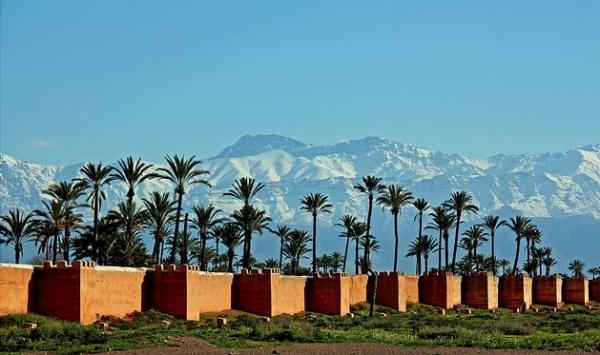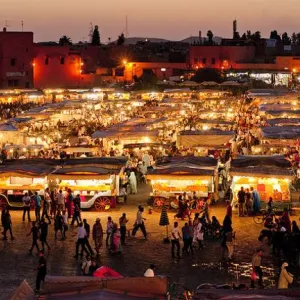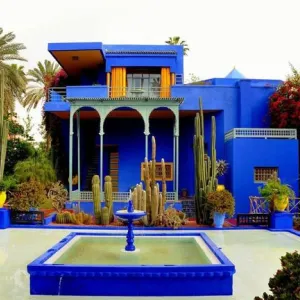Marrakech: Discover the Red City's Exotic Charm
A medieval city of drama, myth and mystery, Marrakech will captivate all who venture behind its ochre-coloured walls. Step inside and you will be transported back to a place and time that has been consigned to the annals of history.
The winding alleys of the medina and the sights, sounds and smells of the souks, the human drama that is Djemaa el-Fna square and the Atlas Mountains rearing up in the background, make Marakech Morocco’s crown jewel.
The city is divided into two highly contrasting districts: the medina, founded by the Almoravids nearly 1,000 years ago, and the Ville Nouvelle, a French colonial modernist project from the early 20th century. It is the medina, and its central square Djemaa el-Fna, that will undoubtedly spark the imagination. Djemaa el-Fna is the heart and soul of Marrakchi life, and really comes alive with the setting of the sun, when a caravanasi of food vendors, selling all manner of Moroccan delicacies, descend onto the square.
These are accompanied by snake charmers, wide-eyed story tellers, musicians and performers that lend a medieval scent to the night air. To the north of the square are the important religious buildings and the souks, while to the south are the Imperial quarters where the palaces and monuments of past rulers proudly stand.
The Ville Nouvelle, which in comparison to the medina is a decidedly more ordered and sedate a?air, divides into the areas of Gueliz and Hivernage. Here you will ?nd an array of civic buildings, international hotels, bars and restaurants typical of any modern European city.
When to Go to Marrakesh It is best to try and avoid the summer heat and crowds and visit Marrakesh in the cooler months between September and May. But, some annual events take place in summer which you may not want to miss.
Marrakesh Popular Arts Festival in July. This annual festival attracts folk singers, dancers, fortune-tellers, acting troupes, snake charmers, fire-swallowers and more, from all over Morocco. Since 2000 the festival has also attracted many artists and entertainers from Europe and Asia. The main events take place in the ruins of the 16 century Badi Palace and the Djemma el Fna (main town square - see below). Fantasia is a horse-riding spectacle that includes hundreds of charging horsemen (and women) wearing traditional clothing. It's part of the Popular Arts Festival so it takes place at the same time in July. You can experience the Fantasia in the evenings outside the city walls near the Bab Jdid. If you don't get to see it in July, there's a restaurant that offers the Fantasia as entertainment while you dine, the Chez Ali. Up-market and touristy but I'm sure you won't forget the experience in a hurry.
Imilchil Marriage Feast is a Berber marriage festival where up to forty couples tie the knot. It takes place in Imilchil in the Middle-High Atlas Mountains near Marrakesh. The festival is a great way to experience Berber culture including music and dance. The event takes place after harvest every year so the dates vary, it's usually held late August or early September. Winter in Marrakech From mid-January to mid-February there is usually enough snowfall in the Atlas mountains to accommodate skiers. The Oukaimden ski resort is less than 50 miles away from Marrakech. There are several ski lifts and if they don't work you can always take a donkey up the slopes. If there's not enough snow the views are always spectacular and it's still worth the trip.
What to See in Marrakech Djemma el Fna The Djemma el Fna is really the heart of Marrakech. It is a large central square in the old city (Medina) and during the day it's a perfect place to grab a freshly-squeezed orange juice and a handful of dates. At the end of the afternoon, the Djemma el Fna transforms into an entertainers paradise -- if you're into snake charming, juggling, music and that sort of thing. Snack stalls are replaced with stalls offering more substantial fare and the square comes alive with entertainment that hasn't changed much since medieval times.
The Djemma el Fna is surrounded by cafe's overlooking the square so you can just relax and watch the world go by if you're tired of jostling the crowds below. Be prepared to be asked for money when you take photos of the performers and stop to watch the entertainment. Souqs The souqs are basically undercover markets that sell everything from chickens to high-quality crafts. The souqs of Marrakech are considered to be among the best in Morocco, so if you like shopping and bargaining you'll enjoy yourself tremendously. Even if you don't like shopping, the souqs are a cultural experience you wouldn't want to miss. Souqs are divided into small areas that specialize in a certain good or trade. The metal workers all have their little shops clustered together, as do the tailors, butchers, jewelers, wool dyers, spice merchants, carpet salesmen and so on.
The souqs are situated north of the Djemma el Fna and finding your way around the narrow alleyways can be a bit tricky. Guides are plentiful in Marrakech, so you can always use those services, but getting lost in the chaos is also part of the fun. It's often more interesting to peek into souqs where local wares are being produced than to be taken to yet another carpet shop by your guide. If you get lost, just ask for directions back to the Djemma el Fna.
Majorelle Gardens and the Museum of Islamic Art In the 1920's, French artists Jacques and Louis Majorelle created a stunning garden in the middle of Marrakech's new town. The Majorelle gardens are filled with color, plants of all shapes and sizes, flowers, fish ponds and perhaps the most pleasing aspect, tranquility. The designer Yves Saint Laurent now owns the gardens and has also built himself a house on the property. The building that gets most of the attention, however, is the bright blue and yellow building the Marjorelles used as their studio and which now houses the Museum of Islamic Art. This small museum includes some good examples of Moroccan tribal art, carpets, jeweler, and pottery. The gardens and museum are open daily with a 2-hour lunch break from 12-2pm.
When to Go to Marrakesh It is best to try and avoid the summer heat and crowds and visit Marrakesh in the cooler months between September and May. But, some annual events take place in summer which you may not want to miss.
Marrakesh Popular Arts Festival in July. This annual festival attracts folk singers, dancers, fortune-tellers, acting troupes, snake charmers, fire-swallowers and more, from all over Morocco. Since 2000 the festival has also attracted many artists and entertainers from Europe and Asia. The main events take place in the ruins of the 16 century Badi Palace and the Djemma el Fna (main town square - see below).
Fantasia is a horse-riding spectacle that includes hundreds of charging horsemen (and women) wearing traditional clothing. It's part of the Popular Arts Festival so it takes place at the same time in July. You can experience the Fantasia in the evenings outside the city walls near the Bab Jdid. If you don't get to see it in July, there's a restaurant that offers the Fantasia as entertainment while you dine, the Chez Ali. Up-market and touristy but I'm sure you won't forget the experience in a hurry.
Imilchil Marriage Feast is a Berber marriage festival where up to forty couples tie the knot. It takes place in Imilchil in the Middle-High Atlas Mountains near Marrakesh. The festival is a great way to experience Berber culture including music and dance. The event takes place after harvest every year so the dates vary, it's usually held late August or early September.
Winter in Marrakech From mid-January to mid-February there is usually enough snowfall in the Atlas mountains to accommodate skiers. The Oukaimden ski resort is less than 50 miles away from Marrakech. There are several ski lifts and if they don't work you can always take a donkey up the slopes. If there's not enough snow the views are always spectacular and it's still worth the trip.
What to See in Marrakech Djemma el Fna The Djemma el Fna is really the heart of Marrakech. It is a large central square in the old city (Medina) and during the day it's a perfect place to grab a freshly-squeezed orange juice and a handful of dates. At the end of the afternoon, the Djemma el Fna transforms into an entertainers paradise -- if you're into snake charming, juggling, music and that sort of thing. Snack stalls are replaced with stalls offering more substantial fare and the square comes alive with entertainment that hasn't changed much since medieval times.
The Djemma el Fna is surrounded by cafe's overlooking the square so you can just relax and watch the world go by if you're tired of jostling the crowds below. Be prepared to be asked for money when you take photos of the performers and stop to watch the entertainment.
Souqs The souqs are basically undercover markets that sell everything from chickens to high-quality crafts. The souqs of Marrakech are considered to be among the best in Morocco, so if you like shopping and bargaining you'll enjoy yourself tremendously. Even if you don't like shopping, the souqs are a cultural experience you wouldn't want to miss. Souqs are divided into small areas that specialize in a certain good or trade. The metal workers all have their little shops clustered together, as do the tailors, butchers, jewelers, wool dyers, spice merchants, carpet salesmen and so on.
The souqs are situated north of the Djemma el Fna and finding your way around the narrow alleyways can be a bit tricky. Guides are plentiful in Marrakech, so you can always use those services, but getting lost in the chaos is also part of the fun. It's often more interesting to peek into souqs where local wares are being produced than to be taken to yet another carpet shop by your guide. If you get lost, just ask for directions back to the Djemma el Fna.
Majorelle Gardens and the Museum of Islamic Art In the 1920's, French artists Jacques and Louis Majorelle created a stunning garden in the middle of Marrakech's new town. The Majorelle gardens are filled with color, plants of all shapes and sizes, flowers, fish ponds and perhaps the most pleasing aspect, tranquility. The designer Yves Saint Laurent now owns the gardens and has also built himself a house on the property. The building that gets most of the attention, however, is the bright blue and yellow building the Marjorelles used as their studio and which now houses the Museum of Islamic Art. This small museum includes some good examples of Moroccan tribal art, carpets, jeweler, and pottery. The gardens and museum are open daily with a 2-hour lunch break from 12-2pm.










